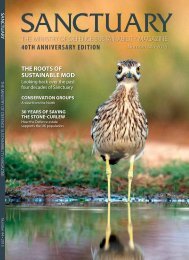SUSTAINABILITY
UC30G
UC30G
You also want an ePaper? Increase the reach of your titles
YUMPU automatically turns print PDFs into web optimized ePapers that Google loves.
FEATURES<br />
Bog mosses find a<br />
new home at Warcop<br />
never been undertaken in the North<br />
Pennines before and 150 bags full of<br />
bog mosses were successfully collected<br />
and spread in the water channels at<br />
Warcop. The sphagnum will soak up<br />
excess water, hold water during the<br />
drier months and grow and expand to<br />
cover nearby areas of bare peat.<br />
Wooden dams installed to slow running water © Alistair Lockett<br />
Sphagnum mosses, also known as bog<br />
mosses, are amazingly multi-coloured<br />
plants that form a protective carpet<br />
across a healthy peatland. They keep<br />
the peat wet, prevent it from eroding<br />
and they are vital for the accumulation<br />
of peat. As a healthy sphagnum<br />
covered peatland accumulates, it takes<br />
in and stores huge amounts of carbon,<br />
much more than any woodland of the<br />
same size. However, if a peatland has<br />
lost its vegetation for one reason or<br />
another, instead of taking in and<br />
storing carbon it releases it into the<br />
atmosphere which contributes to<br />
climate change. It is estimated that a<br />
hectare of bare peat releases 31 tonnes<br />
of C02 every year. This is equivalent to<br />
flying from London to Sydney, and<br />
back again, three times.<br />
Bare peat restoration began on Warcop<br />
Military Range in 2013, organised and<br />
funded by the North Pennines AONB<br />
Partnership (see article in Sanctuary<br />
2013). This work will restore 25ha of<br />
bare and eroding peatland into a<br />
healthy and functioning peatland, with<br />
a good cover of sphagnum moss. Initial<br />
works included installing wooden<br />
dams along eroding channels, which<br />
slow running water, raise the water<br />
table adjacent to the channels and trap<br />
any peat that is being washed down<br />
the channel.<br />
The second stage of this work involved<br />
moving large amounts of sphagnum<br />
moss from a donor site in<br />
Northumberland to its new home at<br />
Warcop. A project of this scale has<br />
The bare peat areas will now be<br />
monitored for the next ten years and<br />
already there are positive signs of<br />
improvement. During a recent survey,<br />
vegetation cover has increased from<br />
an average of 10% to 18% over just<br />
one growing season. The hope is that<br />
this trend will continue and the area<br />
will be well on its way to becoming a<br />
healthy blanket bog after the project<br />
has finished.<br />
Emma Taylor, Peatland Programme<br />
Field Offcer said: “ Warcop is a huge<br />
upland site and we have only just<br />
scratched the surface of what could be<br />
done to restore these damaged peatlands.<br />
The MOD and Landmarc staff fully<br />
support the work and it is uplif ting to see<br />
results af ter such a short space of time. We<br />
hope to continue to work in partnership<br />
with the MOD to restore other damaged<br />
areas of the fell as long as there is<br />
available funding.”<br />
Alistair Lockett<br />
Field Offcer<br />
North Pennines AONB Partnership<br />
Peatlands provide many ecosystem<br />
benefits to both local and the wider<br />
population. Not only does a healthy<br />
peatland mitigate against climate<br />
change by taking in and storing<br />
carbon, it plays an important role in<br />
water quality and supply. For example,<br />
70% of the UK’s drinking water comes<br />
from the uplands. Peatlands are also<br />
nationally and internationally<br />
important for declining and globally<br />
threatened species including lapwing,<br />
curlew and golden plover.<br />
Sphagnum growth behind wooden dam, one year after it was transplanted © Emma Taylor<br />
Sanctuary 44 • 2015<br />
21



